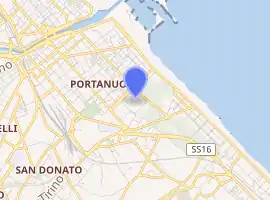Stadio Adriatico – Giovanni Cornacchia
The Stadio Adriatico – Giovanni Cornacchia is a stadium in Pescara, in the italia region Abruzzo. It opened in 1955 and was designed by the italian architect Luigi Piccinato. It hosted some games for the football preliminaries during the 1960 Summer Olympics.[2] It originated as a multipurpose athletic facility and a center for the Italian National Olympic Committee. Today, the stadium is intended primarily for football and athletics and is the home stadium of Serie B club Delfino Pescara 1936.
Stadio Bianco-Azzurro | |
.jpg.webp) | |

| |
| Location | Viale Vittorio Pepe 65126 Pescara |
|---|---|
| Coordinates | 42.45535°N 14.22947°E |
| Owner | Comune of Pescara |
| Capacity | 20,515 |
| Field size | 105 x 68m[1] |
| Surface | Grass |
| Construction | |
| Broke ground | 1955 |
| Opened | 29 December 1955 |
| Renovated | 2009 |
| Architect | Luigi Piccinato |
| Tenants | |
| Delfino Pescara 1936 (1955-present) Italy national football team (selected matches) | |
The stadium, which completed its renovation works in 2009, was the main stadium of the 2009 Mediterranean Games. In the past, it hosted several matches with the Italian national football team. The Adriatico was also selected as a reserve stadium for the 1990 World Cup.
History
The oval-style stadium was designed by Luigi Piccinato along the lines of the Stadio Olimpico in Rome. From an architectural perspective, it is of interest for its use of arches to support the bleachers. Originally, the stadium had one-level stands and could only accommodate 10,000 spectators. After Pescara Calcio's first promotion to the Serie A in 1977, the stadium was subject to the widening of the Curve and also to the stands with the addition of a second level. It resulted in the stadium to be able to accommodate 34,000 spectators. Prior to the Heysel Stadium disaster, when stadium security and regulations were less strict, the stadium was able to hold up to 40,000 paying spectators.
Renovation
In 2009, the stadium completed renovation to better accommodate the 2009 Mediterranean Games, which Pescara hosted. At the end of the renovation (total cost of around €15,000,000), the stadium capacity was set at 24,400 seats. Tribuna Maiella/Poltronissime sections were covered with a laminated wood and include air-conditioned VIP areas, a new press box, and reclining seats. Modernized elevators were also added to accommodate the VIP sections and the press box. The ground level bleachers were demolished and rebuilt, but the original structure designed by architect Luigi Piccinato was retained.
Renaming
On 22 October 2009, the stadium was renamed to honour Giovanni Cornacchia, an Olympic hurdler and native of Pescara.[3]
Serie B side Lanciano moved into the ground to mark their debut campaign at the level, as their stadium was yet to meet Serie B standards.
